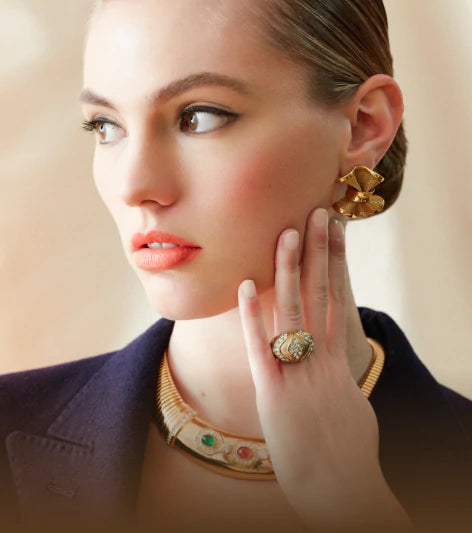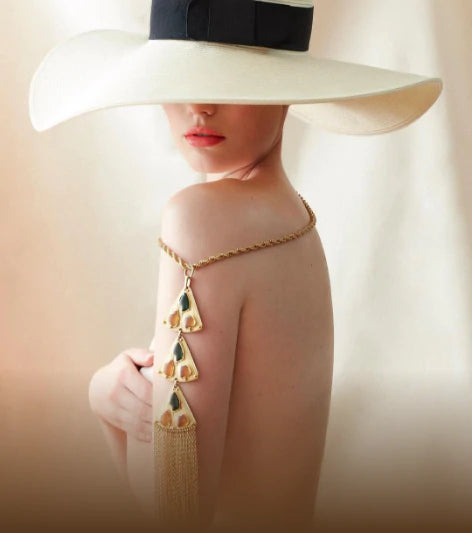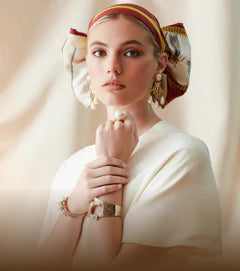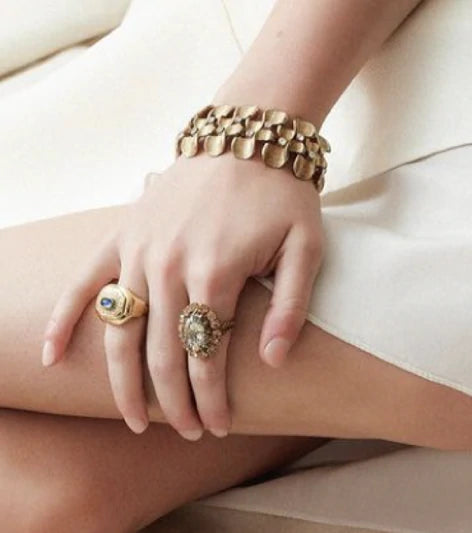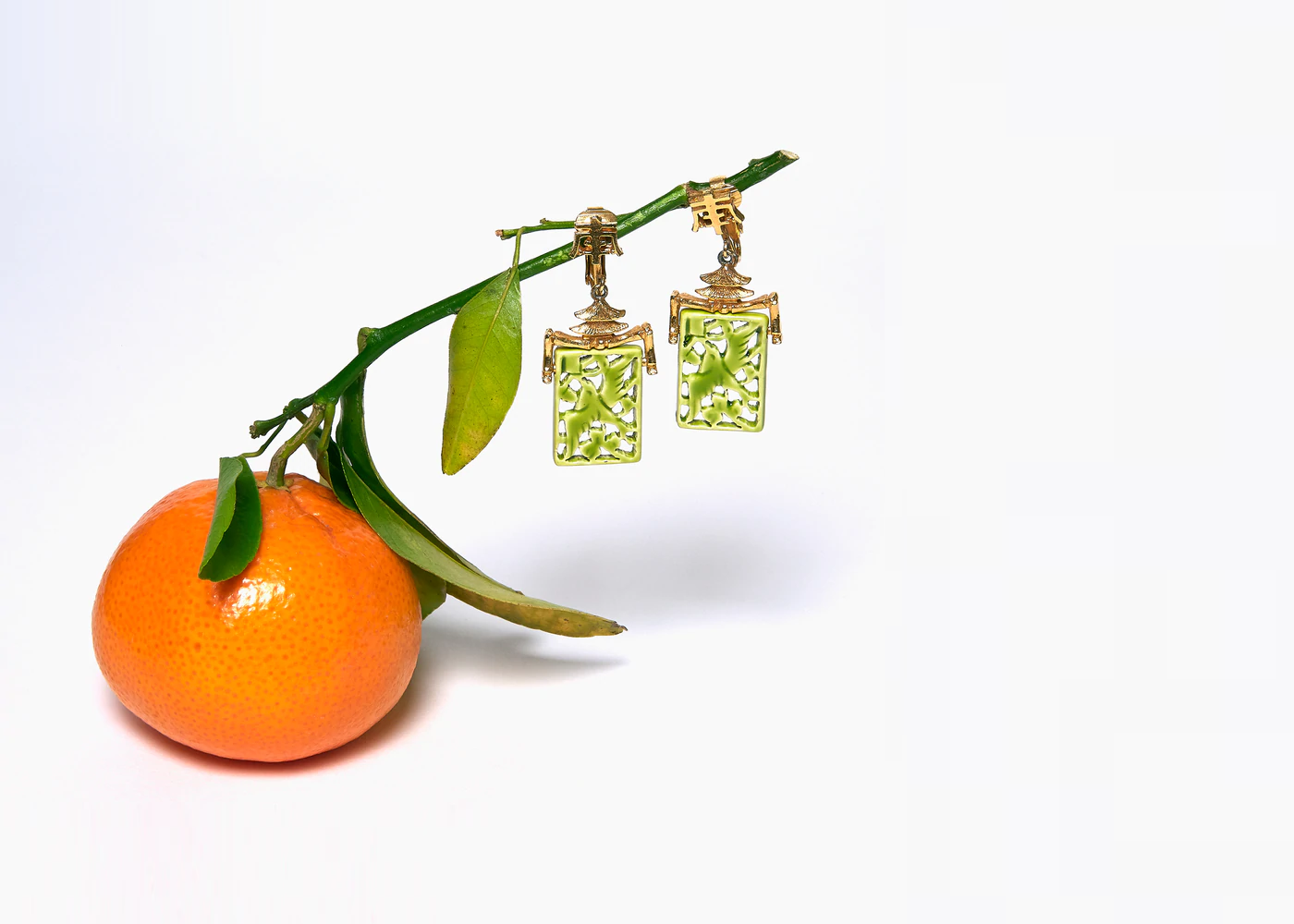Andrée Bazot
Bazot is a French designer who began her career in Paris in 1945. Most of her pieces were produced between 1950 and 1970. She is widely known for her work in French enamel over copper with crushed colored glass incorporated into her designs. Her pieces are known for their ‘free form’ way of structure and inclusion of enamel on both the reverse and front, with her signature salmon pink enamel on the back.
Angela Caputti
Angela Caputti is an Italian designer who opened her own company in Florence in 1975. She creates distinct pieces designed from materials such as resin and plastic that are recognized as some of the most notable in haute couture costume jewelry and are also displayed in museums such as the Metropolitan Museum of Art. Caputti continues to design and her flagship store is located in Florence, Italy.
ART
ART was founded in the 1940s by Arthur Pepper in New York. ART jewelry was often marked with ‘ART’ or ‘ModeArt.’ ART produced a myriad of costume jewelry in different styles between 1950 and 1960. The jewelry was sold across department stores in America. Art pieces make use of materials like filigree metalwork, enamel, multi-colored plastic, and colored rhinestones. Common motifs include flowers, fruit, and leaf, as well as different animals. The company closed in the 1970s.
Avon
David McConnell founded Avon in 1886 in the US originally under the name “Avon Products.” The company became known for door-to-door sales of beauty products and makeup. In 1971, Avon released its first jewelry pieces. Avon continued to release jewelry pieces and collections by well-known designers such as Kenneth Jay Lane, and in 1975, it became the largest manufacturer of jewelry in the world. The company continues to this day.
Barclay
Barclay was founded in New York City in 1947 by Louis Mark, Alvin Rice, and Robert Rice. Much of the manufacturing of the brand was done in Providence, Rhode Island, but the company had an office on Fifth Avenue during their time of operation. Barclay jewelry was popular due its accessibility and affordability; it was sold in various department stores, jewelry stores, and specialty stores. Barclay ceased operation in 1957. The Barclay mark is sometimes confused with being a label of McClelland Barclay, who was a different designer and had a different mark.
Castlecliff
Castlecliff was founded in 1945 in New York City. The company operated its headquarters on Fifth Avenue for several years, earning a reputation for manufacturing high quality costume jewelry. Most of Castlecliff’s pieces were produced under chief designer William Markle between the 1940s and 1970s. From 1970 to 1972, the well-known designer Larry Vrba created pieces for Castlecliff. The company still produces both new designs and sells its vintage pieces.
Christian Dior
Christian Dior started the famous French fashion house and showed his first collection in 1947, introducing groundbreaking silhouettes and pieces with a ‘new look.’ He started out designing jewelry only for a select group of private clients, but by 1948, he began creating pieces for his collections. Dior employed some of the most talented costume jewelry designers of the time including Henry Schreiner and Robert Gossens. Dior’s pieces made use of unique stones, pastes, and often used multi-colored line of rhinestones from Swarovski. The company continues to be a leader in global fashion.
Christian LaCroix
Christian LaCroix is a French fashion designer who opened his Parisian fashion house in 1987. Shortly after opening, LaCroix began producing hatue couture and ready to wear costume jewelry to enhance his garments. LaCroix’s jewelry is best known for being striking gold pieces in eye-catching shapes. Typically, the pieces also sport vibrant colored faux stones, enamel, and rhinestones. LaCroix’s signature pieces include his gem-encrusted crosses and adorned charm bracelets.
Ciner
Ciner was founded by Emanuel Ciner in New York City in 1892. Ciner began as a fine and precious jewelry company but by 1930, it switched to making high-quality costume jewelry. Ciner used his talent to craft his costume jewelry to look like fine jewelry and his pieces had fans like Elizabeth Taylor. Today, the company is still run by the family and continues to design, manufacture and produce its pieces in New York City.
Coro
Founders Cohn and Rosenberger started Coro in 1900, and the brand is a combination of the two owners’ names. Coro started as a boutique that sold outsourced jewelry, but by 1930, they began to manufacture their own pieces with the opening of a factory in Rhode Island. The affordably-priced jewelry was widely adored in the United States, helping to establish Coro’s presence and expand to the opening of factories in Britain and Canada. The company created several other lines such as Corocraft and Vendome, its higher-end brand. The company eventually closed in 1979.
Czech
The northern part of former Czechoslovakia (now the Czech Republic) was known for producing fabulous costume jewelry from 1890 to 1930, hence the mark Czech. Various small factories produced jewelry with glass stones with rich colors of deep purple or pastels. The overall style of Czech jewelry ranged from Art Nouveau and Deco to Egyptian Revival. Czech jewelry was and continues to be popular with collectors as these pieces are incredible well-made and rare.
Eisenberg
Eisenberg was originally started in 1914 as an American clothing company by its founder, Jonas Eisenberg. By 1920, Eisenberg started accessorizing its garments with adorned designs that were either pinned onto or sewed into their garments. Due to the immense popularity of these pins and the inability to separately purchase them from the clothing, Eisenberg started to produce jewelry including necklaces, bracelets, and earrings. From the 1930s to 1950s, Eisenberg was known as some of the finest costume jewelry being made. The company was sold in the late 1970s and continued to produce jewelry into the early 1990s.
Emmons
Emmons Jewelers Inc. was founded in 1949 by Charles H. Stuart in Newark, New York. Taking on a “fanciful” name, according to US Patent and Trademark Office records, the brand was named after Stewart’s wife, Caroline Emmons. Having served as the sister company to Sarah Coventry, which was also founded by Stuart in 1949, Emmons jewelry was produced in the United States, and is valued for its elaborate detail and chic designs. The jewelry was sold through exclusive at-home parties, marketed as “Fine Fashion Jewelry Shows,” and hosted by female brand representatives. The brand ceased production in 1981.
Florenza
Florenza jewelry was founded by Daniel Kosoff in the late 1930s in New York. The brand was named after his wife, Florence. Florenza pieces had an antique style, drawing inspiration from the Renaissance and Victorian ages. Florenza expanded its production to ring boxes, picture frames, lipstick holders, and pin cushions. By 1981, the company had closed its operations.
Givenchy
Hubert de Givenchy was the creative director of Schiaparelli in 1947 and stayed at the famous couture house for 4 years before opening his own House of Givenchy in Paris in 1952. The House of Givenchy quickly dominated the fashion world with its elegant and modern pieces that were worn by equally classy and elegant women such as Jacqueline Kennedy Onassis and Givenchy’s muse, Audrey Hepburn. Givenchy retired in 1995 and passed away in 2018. Today, the brand continues to be a leading global fashion house.
HAR
The company Hargo Creations was started in New York City in 1955 by the husband-and-wife team of Joseph Heibronner and Edith Levitt. Their brand, HAR soon became known for its signature ornate fantastical pieces including dragon, genie and snake designs made of aurora borealis Swarovski crystals and high-quality enamel. Joseph died in 1968, and the company closed down shortly thereafter.
Hattie Carnegie
Born Henrietta Kanengeiser in Vienna, Austria in 1886, she emigrated to the United States with her parents and grew up on the Lower East Side of Manhattan. It is said that Hattie stood in front of Carnegie Hall one day and decided to rebrand herself by changing her last name for more prestige. She launched a hat making business in 1909 which quickly expanded to women’s fashion and jewelry by 1918. Hattie had a great eye for spotting talent. In 1928, Carnegie found a muse in an unknown Lucille Ball, who began as an in-house model and who died her brown hair blonde at Hattie’s request. Many fashion designers also got their start at her brand, such as Norman Norell, Pauline Trigère, and James Galanos. She passed away in 1956 and her pieces are in the collections of the Metropolitan Museum of Art and the Fashion Institute of Technology.
Hobé
Hobé is known largely for its costume jewelry which often made for the film and theater industry. Hobe was founded in the mid-19th century in Paris by William Hobé, and the company moved to New York City in the mid 1920s. Hobé began making costumes and jewelry for the famous Ziegfeld Follies showgirls and then established Hobé et Cie in the US in 1927. Top Hollywood stars such as Bette Davis and Ava Gardner were huge fans of Hobé. The company eventually was sold in the late 1990s.
Hollycraft
Hollycraft was a family business founded around 1936-1938 and based in New York City. Not only did the company manufacture its own brand of costume jewelry, but they also manufactured jewelry for other popular brands at the time, such as Weiss. Hollycraft jewelry is known for its use of pastel-colored rhinestones and vivid colors. Hollycraft was sold in 1970 and stayed in business for 10 additional years before it closed.
Jomaz
The brother duo of Joseph and Louis Mazer started the jewelry company Mazer Brothers in 1927 in New York City. Mazer Brothers began making stunning costume jewelry at affordable prices. They hired former Cartier designer Marcel Boucher to work for their brand in the 1930s. In 1946, Joseph Mazer went on to establish his own company under the name Joseph J. Mazer & Co., eventually shortening it to Jomaz. Joseph Mazer passed away in the 1960s, and the company briefly passed through some family members hands before ending production in 1981.
Juliana
Juliana was founded in 1947 and began by manufacturing buttons, belt buckles, pins, and pendants for the designers Hattie Carnegie, Hobe, and Weiss. In 1967, DeLizza and Elster decided to create their own brand by marking their pieces only with paper tags saying ‘Juliana.’ Juliana stayed in production for about two years, before changing to the brand, DeLizza and Elster.
Karl Lagerfeld
Karl Lagerfeld had a prolific career as a leading creative influence within the fashion industry. He was born in Hamburg, Germany in 1933. His career, however, started in Paris when he became a design assistant at the House of Balmain in 1955. He soon developed a reputation as a premier freelance designer, particularly from his work for the french fashion house, Chloé. In 1965, he embarked on a fifty-four year collaboration with the Italian fashion house Fendi, transforming and elevating the brand. Lagerfeld performed this transformation again, when he joined the French fashion house Chanel in 1982 to head its haute couture line. His designs quickly turned around lackluster sales and lead to a thirty-seven year partnership with Chanel. In 1984, he founded his own bespoke brand, Karl Lagerfeld. Throughout his lifetime, Lagerfeld helmed the fashion houses of Fendi, Chanel, and Karl Lagerfeld until his untimely death in 2019.
Kenneth Jay Lane
Kenneth Jay Lane graduated from the Rhode Island School of Design in 1954 and then moved to New York City. He worked in the art department at Vogue, then at Dior designing shoes, and then at Hattie Carnegie before starting his own collection in 1962. He was known for making fake jewelry just as chic as real jewelry and creating “Fabulous Fakes.” Kenneth Jay Lane was very meticulous with the materials being used for his pieces that he had stones made for him specifically in Germany. His pieces were extremely popular with Jackie Kennedy, Elizabeth Taylor, Audrey Hepburn, and the Duchess of Windsor. He passed away in 2017 but his company continues to this day.
Kramer
Kramer was founded in New York City in 1943 by Louis Kramer. Kramer loved to design in a style which was rich in faux stones and extravagant. Kramer was so skilled in the field of jewelry making that he received an invitation from Christian Dior in 1950 to manufacture costume jewelry for him and the company produced many pieces for Dior in the 1950s and 1960s. Despite the jewelry’s popularity and support by Dior, in the 1970s Kramer stopped production.
Kunio Matsumoto for Trifari
In the 1970s, Japanese architect Kunio Matsumoto created a bespoke line for the jewelry designer and company, Trifari. The line was highly popular during its day and the architectural whimsey and attention to detail can be seen in his pieces. For more information on Trifari, please see below for separate information about the brand.
Les Bernard
After working for the jewelry company, Vogue for many years, Lester Joy and Bernard Shapiro founded Les Bernard in 1963. Les Bernard was a jewelry manufacturing company for high end fashion designers such as Mary McFadden and James Galanos. They also designed and sold their own line, which was popular in the 1970s-1980s. Les Bernard also created a Dynasty jewelry line in conjunction with the famous 1980s television show. The company closed in 1996.
Miriam Haskell
Miriam Haskell began her career in the costume jewelry business in 1924 when she opened a store in New York City selling costume jewelry by other designers such as Coco Chanel. In 1926, she decided to establish the Miriam Haskell Company and appointed Frank Hess as chief designer. Together, the pair worked create unique and innovative pieces. In 1930, she opened her own retail section in Saks Fifth Avenue stores and dominated the costume jewelry industry. Her signature style includes woven tapestry-style beading onto intricately designed filigree backs. She passed away in 1981, but her company is still in operation today.
Monet
Monocraft Products Company Inc. was founded by brothers Jay and Michael Chernow in 1929 in Providence, Rhode Island. Initially, the company made art-deco style purse adornments. By 1937, their brand Monet began creating costume jewelry. In 1981, Monet collaborated with Yves Saint Laurent to produce designs created by the master. The brand dominated the costume jewelry market in the 1970s and 1980s and changed ownership many times and was purchased by Liz Claiborne in 2000.
Napier
Napier was originally founded under the name Whitney & Rice in 1875 in Massachusetts and by 1883, the company had opened an office in New York City. Following World War I, the company changed its name to Napier, and by 1944 it was the largest privately owned manufacturer of fashion jewelry in America. The company was prolific in the 1950s and 1960s, producing hundreds of designs a year. The company closed in 1999.
Nettie Rosenstein
Nettie Rosenstein initially began her career as a dressmaker in 1916. By 1931, her business had expanded to jewelry, handbags, perfume, and lingerie. By 1937, Nettie’s business was grossing $1 million a year ($19.5 million in today’s dollars). Signature pieces of Nettie include her vibrant pave set rhinestone earrings and pins. She made use of enamel and silver work in her jewelry making, and often drew inspiration from the art-deco style. Nettie decided to discontinue her fashion line in 1961 but continued her jewelry and accessory business until 1975.
Nina Ricci
Maison Nina Ricci was founded in 1932 in Paris by Robert Ricci. It was a gift for his mother, Maria “Nina” Nielli, who previously worked at the House of Raffin for 24 years. Robert proposed the idea of founding a fashion house to be creatively led by his mother, and managed by him. Established as an haute couture house, Nina Ricci gained a wide acceptance and following. Maria Niella served as creative director of the brand until 1954 and passed away in 1970. Since then, the brand has been led by numerous designers and is currently run by Harris Reed. The house is still in operation, with contemporary clientele that includes Jennifer Aniston, Reese Witherspoon, and Harry Styles.
Oscar de la Renta
Oscar de la Renta was born into the high society of the Dominican Republic in 1932. He founded his label in 1967 after working under the houses of Cristobal Balenciaga and Lanvin in Spain and Paris. He started out creating clothing and eventually began designing costume jewelry to integrate into his runway shows and looks. Prominent clients included Jacqueline Kennedy Onassis, who enjoyed his elegant and feminine designs. Oscar de la Renta passed away in 2014, but his fashion house remains to this day.
Panetta
Bernardo Panetta worked in Italy as a fine jeweler. He then moved to New York City and worked for Trifari before founding Panetta in 1945. Panetta wanted the quality of his jewelry to resemble fine jewelry as much as possible. The company did not mass produce their jewelry, and as a result, their pieces are not as easy to acquire as other vintage brands. After Bernardo’s passing, his sons took over the brand, and the company stayed in operation until it officially closed in 1995.
Paolo Gucci
Paolo Gucci was born in Florence, Italy in 1931 and was the grandson of Guccio Gucci, the founder of Gucci. He was the creative director of Gucci in the 1960s-70s and was credited with creating the double G logo, among many of the classic designs for Gucci. He had a falling-out with his family and founded his own brand in London in 1983. It was followed by legal battles between him and the Gucci company over the right to use his name. Paolo’s business filed for bankruptcy in 1993. He passed away in 1995 from liver failure, a few months after his cousin, Maurizio Gucci was murdered. He was portrayed by the actor Jared Leto in the 2021 film, House of Gucci, which while entertaining, was not historically accurate about him.
Pierre Cardin
Pierre Cardin was a French fashion designer who trained at Schiaparelli in the mid 1940s and went on to establish his own Parisian fashion house in 1950. He revolutionized the fashion industry with the introduction of his modern space-age garments like the bubble dress in the 1960s. Cardin began designing jewelry to go with his pieces on the runway. Signature jewelry pieces of Pierre Cardin are best known for their modernist look. He passed away in 2020, however the house he founded continues to produce fashion today.
RJ Graziano
RJ Graziano founded his company in New York City in the early 1980s. He began to make commission-based pieces for Bloomingdales, and following the success of the line, he went to sell his pieces in various boutiques and department stores across America. In 2007, Graziano was named one of the top ten best jewelry brands. Celebrities like Katy Perry, Taylor Swift, and Rihanna have been seen wearing Graziano pieces. The company is still in business today, with their studios still based in New York City.
Roberta di Camerino
Giuliana Coen started the handbag company in Venice, Italy in the 1950s. Soon, fashion icons like Grace Kelly, Elizabeth Taylor, Gina Lollobrigida, and Farrah Fawcett were spotted wearing her bags. Using famed quality Venetian fabrics such as velvet and brass hardware made from the same craftsmen who worked on Venice’s famous gondolas, she quickly rose to the top of the fashion world. In 1975, she opened a boutique on Fifth Avenue in New York City and in 1980, the Whitney Museum of American Art held an exhibit on her designs. The brand continues to this day.
Sandor
Sandor was founded in 1938 in New York City by Sandor Goldberger. The company was known for its craftsmanship and designs, which rivaled the fine jewelry of its time. Best known for their figural flower enamel brooches, Sandor pieces are rare and sought after by collectors due to the high quality of their work. Sandor ceased operation in 1972.
Sarah Coventry
Charles H. Stuart founded Sarah Coventry in 1949 in Rhode Island and named the company after his granddaughter. All the jewelry was produced in Rhode Island, and it was sold through representatives who would conduct house visits and host jewelry parties in client’s homes. The pieces were extremely popular in the 1950s-70s, and Sarah Coventry was a household name until the company went bankrupt in 1981.
Scaasi
Arnold Isaacs was a Canadian born in 1930 who studied fashion in Montreal before moving to Paris in the 1950s. After being told to change his last name to stand out, he reversed the spelling to ‘Scaasi’. He then moved to New York where he worked for the couturier Charles James. He formed his own line in 1955 and his red dress was featured on the Christmas cover of Vogue Magazine. He designed the scandalous see-through rhinestone pantsuit worn by Barbara Streisand when she won the 1969 Oscar for Funny Girl, and the blue velvet dress worn by the new first lady, Barbara Bush to the 1989 Presidential Inaugural Ball. Scaasi was also known for his bold jewelry and made use of materials like gold and silver plating, pearls, and Swarovski rhinestones. He eventually sold his jewelry factory to Kenneth Jay Lane and died suddenly of a heart attack in 2015.
Schiaparelli
Elsa Schiaparelli was an Italian aristocrat who moved to Paris in the 1920s. She worked with the famous fashion designer, Paul Poiret, who introduced her to the world of couture. In 1927, Schiaparelli went on to establish her first couture house. Schiaparelli was friendly with Surrealist artist, Salvador Dali and her line was considered the main competitor of her contemporary, Coco Chanel. Schiaparelli’s fashion and jewelry had whimsical themes that featured flowers, bugs, and non-conventional styles such as a hat in the shape of a shoe. In 1932, she was the first woman to grace the cover of Time magazine. She moved to New York from 1941-1945 during World War II. Schiaparelli closed her house in 1954 and passed away in 1973. The house reopened in 2012, with Christian Lacroix designing an haute couture collection for it in 2013. In 2019, designer Daniel Roseberry became artistic director and continues to lead the brand in an edgy surrealist style that is true to its roots.
Schreiner NY
Schreiner NY was founded by Henry Schreiner in 1951. Schreiner began his career by creating jewelry for the houses of Norell and Christian Dior before founding his own brand. Schreiner is best known for his glass work done on necklaces, pins, and earrings. One of his signature pieces includes the ruffle brooch, which has triangular-shaped glass overlapping in a starburst pattern from a signature central stone. Schreiner was known for his eccentric designs and high-quality craftsmanship, making his eye-catching unique pieces favorite for vintage costume jewelry collectors.
Stanley Hagler
Stanley Hagler began his design career as an assistant to Miriam Haskell in the 1940s. In 1953, he established Stanley Hagler Jewelry and Co. in New York City and created his jewelry designs for famous clients such as the Duchess of Windsor. Best known for his elaborate floral designs, Hagler’s signature work used hand wiring of materials such as art glass stones, Swarovski crystals, rose montees, seed pearls and beads, and Russian gold-plated filigree. He passed away in 1996.
Trifari
Trifari was established in 1910 in New York City by Gustavo Trifari and his uncle under the name Trifari & Trifari. In 1912, Gustavo broke away from his uncle and began producing high-quality pieces under the name Trifari. Due to World War II, Trifari had to shift from using base metals to using sterling silver- Trifari went on to create ‘Trifanium,’ a special alloy. Hollywood and Broadway stars loved wearing Trifari pieces, helping to catapult the success of the brand. First Lady, Mamie Eisenhower, commissioned Trifari to make her jewelry for her inaugural ball outfits in 1953 and 1957. The brand basically ended when the company was bought by the Monet Group in 1994, and then it was acquired by Liz Claiborne in 2000.
Valentino
Valentino Garavani was born in Lombardy, Italy in 1932. He moved to Paris to study fashion and apprenticed with Jacques Faith, Balenciaga, and Guy Laroche. In 1960, he founded his own fashion house in Rome with his partner, Giancarlo Giammetti. Valentino made couture dresses for the world’s most glamourous women, including his dear friend, Jacqueline Kennedy Onassis. The house then began making accessories and costume jewelry to compliment the clothes. Some of their jewelry was very limited and often only made for runway wear. In January 2008, Mr. Valentino announced his retirement and presented his last personally designed couture show. He passed the creative direction on to Maria Grazia Chiuri and Pier Paolo Piccioli. In 2016, Chiuri moved to the House of Dior, and Piccioli remained as the sole creative director for the house.
Vendôme
Vendôme was created as the higher-end brand of leading American costume jewelry manufacturer, Coro, around 1944. In 1953, the Vendôme line replaced their other brand, Corocraft, and began operating as a semi-independent subsidiary company. Vendôme was geared to the wealthier American elite in the light of post-war Paris. Vendôme used high-quality materials such as rhinestones, crystal beads, Lucite, and faux pearls. In 1957, Coro and Vendôme were bought out by Richton International Corporation and by 1979, Vendôme was closed.
Vogue
Vogue jewelry was founded in 1936 and was not affiliated with the famous magazine of the same name. Vogue’s signature piece includes their high-quality crystal bead rope necklace that began production in 1950. Other sought-out pieces include the patriotic flag and figural pins that were produced in the 1940s. The founders decided to sell their interests in the company in 1962, but Vogue continued production until 1973, with their jewelry selling in the high-end store department store chain, I. Magnin.
Lawrence Vrba
In 1969, Larry Vrba moved from Nebraska to New York City and worked as a designer for Miriam Haskell. In the 1970s he then worked for William De Lillo, Castlecliff and Les Bernard before forming his own company in 1983. Known for his big, bold and whimsical pieces, he would combine vintage rhinestones and beads into his own contemporary designs. He also worked on costume designs for Broadway shows such as Hairspray and Wicked. His designs were carried in Bergdorf Goodman’s and are celebrated and worn by the world’s most glamorous clientele.
Weiss
Albert Weiss began his career making jewelry for the largest costume jewelry manufacturer, Coro. He went on to establish his own company, Weiss Company, in New York City in 1942. Weiss amassed great success between the 1950s and 1960s, becoming renowned for their well-crafted, rhinestone pieces inspired from Art-Deco geometric designs. Weiss retired in 1960 and handed the company over to his son. The company closed in 1971.
Whiting & Davis
Whiting & Davis was founded in 1876 in Massachusetts and started by producing woven mesh evening bags. By 1907, they started to create jewelry inspired by Victorian and Art Nouveau influences. Whiting & Davis’s mesh chokers are still popular to this day, however, the most sought out piece from this company remains to be mesh bangles adorned with snake heads. Whiting & Davis ceased jewelry production in 1983.
